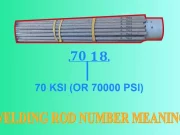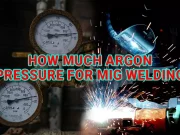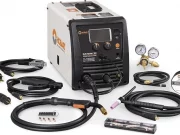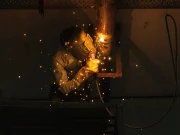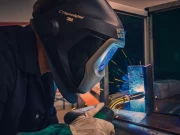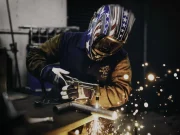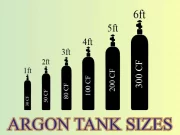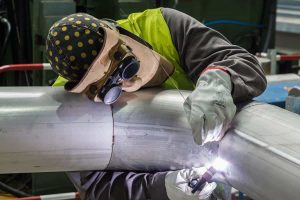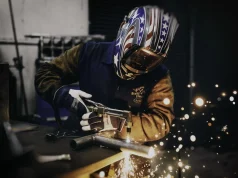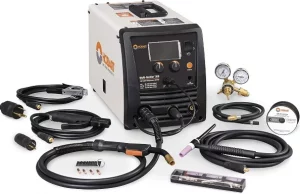Let’s look at this question critically; can you weld stainless steel to mild steel given their differences? In the real sense, in any wielding application, the base materials used need to have similar mechanical compositions and chemical properties. But because the project might end up being too expensive, most welding operators consider dissimilar welding. By the way, it is more economical than building a structure that compromises of steel material only. So, here’s the question once again;
Can you weld dissimilar materials like stainless steel to mild steel?
The answer is yes. You can successfully wield these two dissimilar metal together. However, the success of such a welding application will depend on the filler metal selected for the welding process and the welding procedure deployed. For instance, if you want to join the 304L stainless steel material to, let’s say, mild steel, the filler metal mostly recommended for such is the 309L. You can use the Tungsten Inert Gas (TIG) and Metal Inert Gas (MIG). However, the MIG welding process, which uses filler, is most preferred when welding stainless steel to dissimilar metals, such as mild steel.
So, that’s it about welding stainless steel to mild steel. But there is more you need to know, so continue reading!
Welding Stainless Steel To Mild Steel: Things You Need To Consider
Every wielder wants whatever they are fabricating to come out good. And that is how it should be. Welding materials are quite expensive these days, so one needs to be extra careful and ensure whatever is being fabricated is done to the required standard.
However, joining stainless steel to mild steel won’t be as solid or easy as working with only steel material. But as I said earlier, most fabricated facilities are built with these two dissimilar materials (stainless steel and mild steel).
An example is in some power generation businesses, including a range of mineral and mining processing facilities out there. Steel, no doubt, is more expensive than mild or carbon steel. But because of the need to reduce the cost of the entire project, there may be a need to weld steel material to mild steel because it was usually less expensive.
So, what are the factors that can make welding steel to other dissimilar metals like mild steel, a success?
There are tons of factors to consider, which we are going to be looking out together.
Focus on the properties of the metals you intend to weld
Firstly, before you weld stainless steel to mild steel, you need to consider the properties both metals have. These include the mechanical properties, chemistry, and ability to resist corrosion, as taking the right decision can prevent any trouble that might creep in overtime.
But here is the thing. You can reduce all these concerns by picking the right filler metal for such a welding project that involves stainless steel and a dissimilar metal like mild steel. As a rule of thumb, in such a welding application (stainless steel and mild steel), the filler metal you are settling for should have mechanical properties that are equal to or greater than the lesser of both materials you intend to weld.
Why is picking the right filler metal relevant? You may encounter people asking such questions at times. Please don’t blame them. Any staunch DIYer or welder would be interested in finding the right information to enable them to execute their projects satisfactorily and without issues.
For instance, let’s assume you plan to weld the popular 304L stainless steel and the mild steel. As I said earlier, when dealing with such metals, you can use the 309L metal filler.
Now here’s what happens when you start the welding procedure—it is something that makes this filler metal a wise choice when dealing with such dissimilar metals.
The welded joint will be diluted with both metals. That is stainless steel and mild steel (each coming from both sides of the joint), and will eventually have the materials of both metals mixed. At the end of the process, you will have a weld deposit that has a chemistry that is compatible with what you have on both sides of the welded joint.
So, the little explanation I just gave is what you can achieve by using the 309L grade filler metal to join stainless steel (304L) to mild steel.
Avoid carbide precipitation by adhering to the right heat input.
The one thing that can give rise to carbide precipitation, a condition prevalent among the 300 series austenitic stainless steel, is when they are subjected to extremely high heat for an extended period.
So, it is advisable to maintain proper heat input when welding stainless steel and mild steel. Doing so will help to keep the corrosion resistance properties of the weld deposit, including its alloy content, intact.
What temperature does carbide precipitation occurs? Well, it can happen when you heat the stainless steel material for too long, and at a temperature of 800 – 1400 degrees Fahrenheit.
Please Take Note of this: When welding stainless steel, one of the things you need to focus on is temperature. Monitor the temperature of your base metal and weld metal, as failure to do so may give rise to avoidable performance problems in the long run. And I am sure you don’t want that, no welding operator or DIYer would want to mess with their welding projects.
How can you monitor the temperature? Here’s another equally essential question. Just as we have thermometers for checking body temperatures, there are also devices used to check the temperature of weld and base metal. These include the following;
- The temperature-indicating sticks.
- The Electronic infrared thermometers.
- The electronic surface temperature probes.
Prep Your Metal (stainless steel and mild steel)
Firstly, I would say, have a prepping plan that includes getting all the materials you need for the welding process. And most importantly, keeping the two metals you intend to join together, clean. You need to understand that dirty welds may end up not being strong. So, clean each metal thoroughly to avoid welding imperfection that can be devastating.
Do brand new metals need prepping? Yes, they do. It would help if you cleaned them thoroughly before welding to get rid of foreign materials that can result in welding imperfections.
Furthermore, the type of welding process you intend using will determine how you should prep your metals. If you are going to use the MIG (Metal Inert Gas) welding process, then you can go ahead with the process, even if the metal isn’t perfectly clean. But if you are going to use the TIG (Tungsten Inert Gas), then you need your metals to be extremely clean.
Also, have in mind that welding dissimilar materials like in the case of stainless steel and mild steel can be quite a challenge, particularly for individuals who are doing such for the first time. Even people who may have done it before can encounter a little bit of challenge to get it right.
What counts is the knowledge you have of the welding procedure you intend using. You also need to have sound knowledge of the filler metal and base materials you intend to use for the project.
Stainless Steel Vs. Mild Steel: What Are The Differences?
There exist different types of steel, with each having unique properties that make them ideal for diverse applications. They could differ in strength, corrosion resistance, and weight. Mild steel and stainless steel are two of the popularly used metals, and because of their properties, they are equally suitable for diverse uses.
Now let’s focus on the difference that exists between stainless steel and mild steel. Since you are going to be welding both metals, it would make sense to have a sound knowledge about what differentiates one from the other.
Alright, firstly, let’s take a look at their alloying material. In mild steel, carbon is the alloy material, while for stainless steel, you will find chromium. However, the chromium in the structure of stainless steel is responsible for it is high resistance to corrosion. Additionally, the surface doesn’t get stained or tarnishes.
What about mild steel? Well, this type of steel needs galvanizing to prevent corrosion. Plus, you have to clean to maintain its surface. But then, mild steel is cheaper, which is the reason most individuals consider joining it with stainless steel, instead of the entire fabrication being made of stainless steel material.
Furthermore, another thing that makes stainless steel a wise choice for many applications is its chromium alloy. It gives this metal its hardness and ability to be resistant to impact. However, mild steel is more malleable, and thus, are a breeze to fabricate, a factor resulting from the carbon it contains.
Conclusion
The question was, “can you weld stainless steel to mild steel?” Again, the answer is yes. You can, but you need to choose the right filler metal, and be knowledgeable about the welding process you are going to use to join both metals. It will also help a lot if you know the challenges that may result when joining these two dissimilar metals and do whatever necessary to avert them. So, now that you know you can join stainless and mild steel, I suggest you get on with that project. And thanks for stopping by!




